Rice Profile
Medically reviewed and cowritten by Jamie Johnson, Registered Dietitian Nutritionist (RDN).
Rice Benefits
Did you know in some parts of the world, the phrase ‘to eat’ literally means ‘to eat rice’? Rice supplies about half of the daily calories for half of the world’s population, and for good reason. This versatile grain is rich in B vitamins, iron, and many other nutritious minerals, making it a great option for your baby and kiddos. Eating rice has been shown to help with weight management, reduce the risk of certain cancers, help protect kids against childhood asthma, and lower high cholesterol – what’s not to love?
HEALTH BENEFITS OF RICE
There are tons of different types of rice and each one will have a different nutrient profile, depending on what type it is and how it is processed. Many white rice for instance, have been enriched so that the nutrients lost in the processing from brown rice are added back. But read the label to know which one is right for you and your family. Brown rice has many health benefits since it has been minimally processed.
- High in fiber, which will keep baby’s digestion regular and keep constipation at bay.
- A great source of B vitamins, which are important for our brain and nervous system.
- An excellent source of manganese, necessary for metabolism, calcium absorption and nerve function.
Highlighted Nutritional Importance of Rice
Vitamins
Thiamin – this B vitamin promotes bone and muscle growth, good vision and healthy skin
Niacin – another B vitamin that helps keep skin and gums healthy by maintaining good blood circulation
Folate – this B vitamin supports energy production within each cell in the body and supports a healthy nervous system
Pantothenic Acid – also known as vitamin B5, this vitamin supports the immune system, healthy hormone production and basic metabolic functions of the body
Minerals
Iron – this mineral is a blood building nutrient and enhances the oxygen carrying capacity of red blood cells
Manganese – a potent antioxidant that helps protect cells from damage and helps form bone and cartilage
Selenium – this trace mineral supports the immune system and healthy thyroid function
Phosphorus – about 85% of the body’s phosphorus is found in bone, making it crucial for healthy bone and teeth growth
Zinc – an immune boosting mineral that helps support baby’s appetite and healthy digestion
Brown or White Rice
The difference between brown and white rice is not just in the color, it’s in the processing. A whole grain of rice starts out with 7 layers. The outermost layer, or the hull, is removed to produce brown rice and is the least damaging to the nutritional value. When white rice is produced, the brown rice is milled to remove the bran and most of the germ layer, creating a whiter rice that has unfortunately lost up to 90% of its b vitamin, iron, and mineral content. Many white rices have been enriched with some of these vitamins and minerals to make them a little bit more nutritious, but some have not, so read the label.
How to Select and Store Rice
Rice does have a higher level of arsenic in it than other grains. Unfortunately, organic does not have any less arsenic than conventionally grown, so just be sure to serve a variety of grains.
Since brown rice is minimally processed and still has its oil-rich germ, storing it in an airtight container in the refrigerator is important to avoid rancidity. White rice, on the other hand, should still be stored in an airtight container but can be kept in a cool, dry place rather than the refrigerator.
Cooked rice should be refrigerated in an airtight container and eaten within 2-4 days.
Like all grains, rinse the rice thoroughly under running water to remove any dirt or debris and to prevent sticking. To cook, add one part rice to two parts boiling water or broth, bring to a boil then cover and simmer for about 45 minutes. Of note, brown rice takes longer to cook than white rice to read package instructions. Rice is incredibly versatile and can be eaten on its own, used as a base for nutritious rice puddings or even ground into a powder for homemade rice cereal for baby!

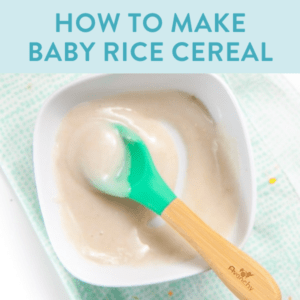
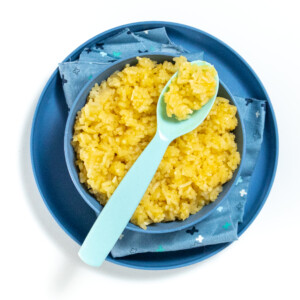
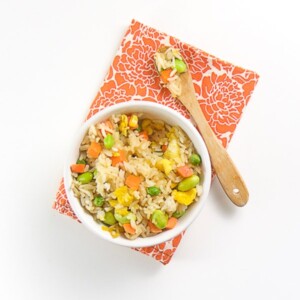
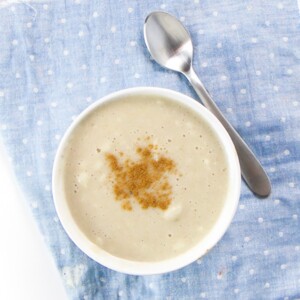
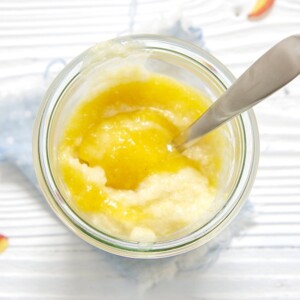
2 Comments on “Rice Profile”
Hi! I used your site and recipes regularly to introduce my now-5-year-old to solid foods and am coming back now with my now-5-MONTH-old. Since I last made my purees, I’ve learned that rice — and especially brown rice — has been found to have elevated levels of arsenic. I see that you mention it in passing in this profile, but wonder whether you have any updates since these concerns have emerged.
EWG now has a page on arsenic concerns in rice: https://www.ewg.org/foodscores/content/arsenic-contamination-in-rice/
Having read everything I can, I’m still having a hard time determining whether I should eliminate brown rice entirely from my purees, or just limit it, in combination with an otherwise varied diet. I’d love your updated take on this issue! Thanks so much for this incredible resource!
Thanks for your comment. Yes, the issue with arsenic and heavy metals in baby foods seems to be popping up more and more lately. I would definitely recommend using organic rice when making baby food versus conventional rice. It doesn’t eliminate arsenic completely from the food, but greatly reduces it. Whether you eliminate it from baby’s diet is completely up to you, as for some people, this isn’t an option. My personal recommendation is that a varied diet is the best diet and to trying to get a wider variety of foods is more important than eliminating rice or other foods found with high levels of heavy metals. Hope that helps.